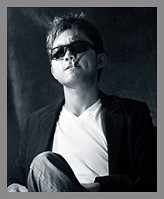 Cast: Toshiro Mifune
Cast: Toshiro Mifune
Director: Akira Kurosawa
Screenplay: Shonibo Hashimoto
Running time: 1 hr 50 mins
Genre: Action/Drama/War
CRITIQUE:
From the classical tragedies of the Greek, to the rise and fall of empires, it has taught us that the greatest frailty of man is the lust for power. Shakespeare’s Macbeth tells us the same. There is another lasting belief of tragedy, adapting a Shakespearean play to screen may be an act of cinematic hubris. Rarely does his eloquent verses, no matter how magnificent they are, works well in the silverscreen. But none the naysayer, Akira Kurosawa translates Macbeth into screen with masterful techniques, making Throne of Blood possibly the most superbly-crafted Shakespearean cinematic adaptation. Just three years breaking new grounds with the epic-actioner Seven Samurai, Kurosawa pushes his art further, crafting a rhythmically consistent, well-paced, mood piece of filmmaking and transforms the complexity of Shakespeare’s language into a filmic expression, minimalist in a way, hence effectively polishing a fluid narrative. Perhaps the ultimate sleight-of-hand is that Kurosawa revises the English category and uproots it into the rich Japanese culture of swords and samurais and codes and honour. Even the dialogues feel intense and cinematic.
For all its glorious theatricality, it serves a material that studies the greedy nature of man for power and position, where Washizu (brilliantly played by Seven Samurai’s Toshiro Mifune) is bewildered between fate and choice after being predicted to become the master of Cobweb Castle by an oracle in the forest. Betrayal ensues and friendships are broken, this doomed supremacy-hungry protagonist is coaxed by a cold, manipulative wife to seize opportunity, which leads to a tragic comeuppance in a deliriously, dazzlingly staged finale, the march of the Cobweb Forest and the death of Washizu by ruthless arrowmen in the tower. That is to say, the spirit of Shakespeare remains, but it’s Kurosawa painting his canvas with dark contrasts, striking images of such elevated art – the mist swirling in the mountains, the rain-lashed forest hunt, the apparition of the oracle, and Lady Asaji’s ominous emergence from the dark shadow – are all visually inspired and poetic. If one notices, the battle scenes are briefly shot, parade of men, cavalcade of horses, an army in a field, and keeps coming back to Washizu and his personal hell, that is, to highlight the central character in his journey to tragedy.
VERDICT:
Kurosawa reclaims his place as a master of epic proportions and visual artistry in Throne of Blood, a spectacular, rock-solid cinematic work that is up there as possibly the finest Shakespearean screen reimagining.
RATING: A+
THRONE OF BLOOD [1957] - Dir Akira Kurosawa, Japan
2009-02-20T19:55:00+08:00
Janz
Movie Review|
Subscribe to:
Post Comments (Atom)
Followers
Blog Archive
- December (3)
- November (1)
- October (6)
- August (2)
- July (3)
- June (4)
- May (4)
- April (8)
- March (3)
- February (6)
- January (11)
- December (2)
- November (7)
- October (4)
- September (9)
- August (8)
- July (11)
- June (13)
- May (12)
- April (7)
- March (11)
- February (14)
- January (16)
- December (6)
- November (15)
- October (3)
- September (11)
- August (10)
- July (16)
- June (10)
- May (11)
- April (2)
- March (6)
- February (16)
- January (15)
- December (3)
- November (3)
- October (9)
- September (8)
- August (4)
- July (8)
- June (9)
- May (9)
- April (21)
- March (13)
- February (12)
- January (12)
- December (6)
- November (25)
- October (18)
- September (13)
- August (14)
- July (12)
- June (18)
- May (8)







